

Crossing an entire continent on board the Trans-Siberian Railway is an experience unlike anything else, it’s truly exceptional. However, we often have a romantic notion of it, without realising that this trip requires very special organisation. In this article, we’ll explain how to prepare for such a trip in detail.
Between 20th February and 15 March 2019, we carried out a large survey among 146 round-the-world (RTW) travellers who’ve taken the Trans-Siberian. We asked them nearly 30 specific questions. You’ll find the figures from this survey throughout this article. Find out more about our Methodology here
The Trans-Siberian Railway isn’t, as one might think, one specific train called the “Trans-Siberian”. Taking the Trans-Siberian means taking a train from Moscow to Vladivostok that crosses Russia, via Siberia, in six days. These trains stop in several towns where you can get off. You can also choose to do the trip all in one go by staying on board until the last stop.
Many national trains follow these same railway lines. You can easily take one after another and do the same trip by buying a new ticket each time.
Aside from a few luxury trains chartered by private companies for well-off tourists, the trains that run on these tracks, including the Trans-Siberian trains, are normal, everyday trains, mostly used by locals.
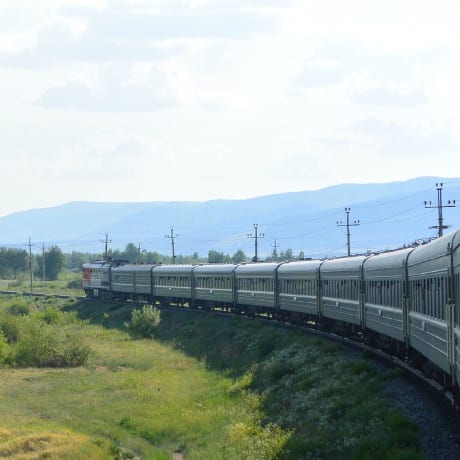

A Trans-Mongolian train, Moscow to Beijing
When talking about Trans-Siberian trains, this often includes the equally important Trans-Manchurian and Trans-Mongolian trains. At first these trains, Chinese or Russian, take the same route as the Trans-Siberian, then they both branch off after Lake Baikal. This allows you to go from Moscow to Ulan Bator or Beijing.
Trans-Siberian, Trans-Mongolian, Trans-Manchurian and all other national trains on these tracks go slowly. Some trains are faster than others, but there isn’t a single high-speed train. On average, these trains reach speeds of 30 mph (50 km/h). The quickest route to get to Ulaanbaatar, Vladivostok or Beijing, without stopping off anywhere, takes 4 to 7 days. In reality, only a handful of RTW travellers do this direct journey.
People are often mistaken in thinking that a Trans-Siberian trip is expensive. The cost varies a lot depending on the trains and the class you decide to go for. If you only take the journey into account, the cheapest direct Trans-Mongolian train from Moscow to Beijing costs around $540 (£410). But, if you take several trains and a bus here and there, you can do the same trip for just $175 (£130).
We’ll tell you more about this in the section on routes.
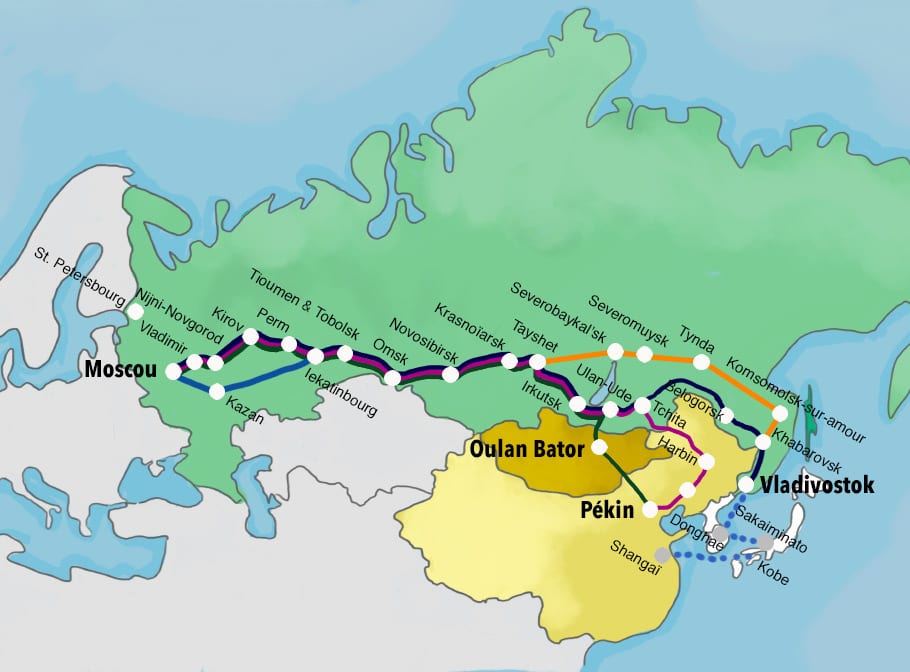

Trans-Siberian
Trans-Mongolian
Trans-Manchurian
Baikal-Amur Mainline (BAM)
South Urals Railway
Ferries
There are only two good reasons for wanting to do the whole Trans-Siberian journey directly and in one go, which is still six to seven days on the same train. One, if you’re quite simply in a hurry, or two, if you want to live the “Trans-Siberian experience” to the max. Some love it, others less so.
In general, train lovers enjoy the contemplative aspect of such a trip. You watch different landscapes go by, you don’t have a care in the world, and you don’t even feel guilty about it… But, above all, it’s an opportunity to meet locals, real ones, in an environment that’s made for socialising.
If you want to do the journey without stops, the only way to do it is to take a direct Trans-Siberian, Trans-Manchurian or Trans-Mongolian train. These trains don’t have a 3rd class (significantly cheaper), but your fellow travellers aren’t likely to change, so you’ll have plenty of time to really hit it off with them.
21% of our survey respondents did this trip directly, with one single train.
One of the main characteristics of RTW travellers is “having time”. So it’d be a shame then not to make a few stopovers. The least we can say is that there are plenty of places worth stopping off at along the route, starting with Lake Baikal and Ulaanbaatar. 78% of our survey respondents did this trip with stopovers.
There’s no open, flexible or unlimited ticket that allows you to hop on and off any train on the route. Nonetheless, there are daily trains on the tracks between Beijing and Moscow – both Trans-Siberian trains and national trains that cover shorter distances. You can easily organise your itinerary to get off one train and get on another. It’s not always necessary, but it’s still sensible to make sure you’ve bought your tickets at least a few days in advance, because the trains are often full, especially in high season in summer.
One of the big advantages of splitting up the trip with stopovers is that it allows you to take 3rd class trains which are much cheaper, so you can make huge savings on the overall journey.
According to our survey, 76% of survey respondents did the entire trip with stopovers. See “The Most Beautiful Stopovers” chapter for some great inspiration.
There isn’t really a difference, except the number of foreign tourists on the trains. There are significantly fewer heading west.
Based on our survey, 78% of respondents travelled east and the other 22% travelled west.
This difference can be explained by the fact that when you go east, Europeans and Brits can prepare their visa applications beforehand from their home country. Whereas, if you do the same trip but go west, you need to get them whilst abroad, which is somewhat more complicated.
Trains run all year round, even in the depths of winter. The Trans-Siberian route covers more than eight time zones and the climate is obviously extremely different from one end to the other, between Moscow, Beijing or Vladivostok. As a general rule:
In winter, the climate is harsh, the days are short and cold, but sunny, and the snowy landscapes on most of the route are truly magnificent. Temperatures around -4° F (-20° C) are normal and can drop exceptionally to -40° F/C. It’s essential to be well-equipped for the cold, like you would be for winter sports. In these conditions, you can easily, and even quite happily, go sightseeing. On board the trains, the cold isn’t an issue. They’re very well heated. In winter, it’s easier to get tickets for international trains that are often full well in advance in other seasons. In January and February, some trains run less frequently.
Around April, temperatures are milder, but the snow melts and there’s lots of mud in places. “In general”, this is the least beautiful time of the year.
From May to September, the weather is pleasant and the days are longer. The heart of summer is the high season. There are lots more foreign tourists. It’s harder to book a ticket at the last minute.
Lake Baikal (almost an unmissable stop on the route) has a different charm at each time of the year. It’s completely frozen from February to April and covered in drift ice until June. The LakeBaikal.com website describes the seasons on Lake Baikal in detail.
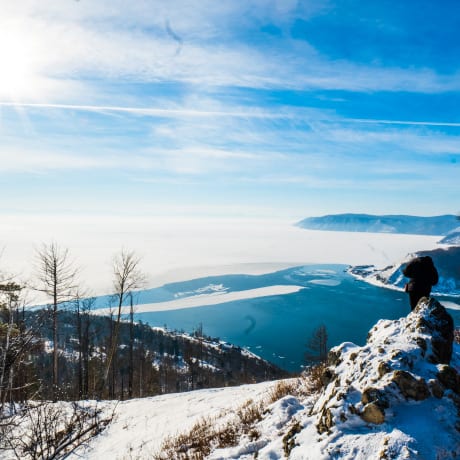

Lake Baikal in January, magnificent and sunny, but freezing


Lake Baikal in summer, milder, less spectacular
Credit: Marie Hatay
Temperature in Celsius
Temperature in Fahrenheit
| GMT+ | January | February | March | April | May | June | July | August | September | October | November | Décember | |||||||||||||
|---|---|---|---|---|---|---|---|---|---|---|---|---|---|---|---|---|---|---|---|---|---|---|---|---|---|
|
avg. temp.
min/max |
record temp.
min/max |
avg. temp.
min/max |
record temp.
min/max |
avg. temp.
min/max |
record temp.
min/max |
avg. temp.
min/max |
record temp.
min/max |
avg. temp.
min/max |
record temp.
min/max |
avg. temp.
min/max |
record temp.
min/max |
avg. temp.
min/max |
record temp.
min/max |
avg. temp.
min/max |
record temp.
min/max |
avg. temp.
min/max |
record temp.
min/max |
avg. temp.
min/max |
record temp.
min/max |
avg. temp.
min/max |
record temp.
min/max |
avg. temp.
min/max |
record temp.
min/max |
||
| St Petersburg | +2h | -11 / -5 | -34 / 9 | -11 / -5 | -37 / 10 | -7 / 1 | -30 / 19 | -0 / 9 | -20 / 26 | 5 / 15 | -7 / 30 | 10 / 20 | -2 / 34 | 13 / 23 | 0 / 35 | 12 / 21 | 0 / 37 | 7 / 15 | -6 / 30 | 3 / 8 | -13 / 29 | -3 / 2 | -23 / 19 | -8 / -2 | -39 / 15 |
| Moscow | +2h | -11/-6 | -35 / 10 | -11 / -5 | -33 / 11 | -6 / 1 | -22 / 17 | 2 / 11 | -16 / 28 | 8 / 18 | -8 / 32 | 12 / 22 | 0 / 33 | 14 / 24 | 0 / 38 | 13 / 22 | 1 / 37 | 8 / 16 | -4 / 29 | 3 / 8 | -12 / 23 | -4 / 1 | -23 / 19 | -9 / -4 | -36 / 9 |
| Kazan | +2h | -16 / -10 | -46 / 11 | -16 / -9 | -38 / 7 | -10 / -2 | -31 / 15 | 1 / 9 | -23 / 30 | 8 / 18 | -7 / 34 | 12 / 23 | 0 / 37 | 14 / 25 | 1 / 38 | 12 / 22 | 1 / 39 | 7 / 16 | -8 / 31 | 1 / 7 | -15 / 30 | -7 / -1 | -28 / 17 | -13 / -7 | -45 / 11 |
| Yekateringburg | +4h | -19 / -11 | -43 / 6 | -19 / -9 | -40 / 9 | -12 / -1 | -37 / 17 | -2 / 9 | -21 / 29 | 4 / 17 | -13 / 33 | 10 / 22 | -3 / 35 | 12 / 24 | 0 / 38 | 10 / 21 | -6 / 37 | 5 / 14 | -7 / 31 | -1 / 6 | -24 / 25 | -10 / -3 | -40 / 13 | -16 / -9 | -44 / 6 |
| Omsk | +5h | -22 / -14 | -42 / 6 | -22 / -12 | -42 / 2 | -14 / -4 | -37 / 15 | -2 / 9 | -26 / 31 | 5 / 18 | -13 / 36 | 11 / 24 | -2 / 39 | 14 / 25 | 3 / 37 | 11 / 22 | -5 / 37 | 5 / 17 | -9 / 38 | -2 / 7 | -24 / 25 | -12 / -5 | -37 / 12 | -19 / -11 | -47 / 7 |
| Krasnoyarsk | +6h | -21 / -13 | -48 / 13 | -22 / -12 | -43 / 8 | -13 / -3 | -37 / 17 | -4 / 7 | -25 / 25 | 3 / 15 | -19 / 38 | 9 / 22 | -3 / 36 | 13 / 25 | 0 / 36 | 10 / 21 | -2 / 34 | 4 / 14 | -12 / 32 | -3 / 6 | -26 / 25 | -14 / -6 | -40 / 15 | -20 / -12 | -42 / 10 |
| Novosibirsk | +6h | -22 / -14 | -47 / 9 | -21 / -12 | -45 / 6 | -14 / -4 | -38 / 13 | -4 / 7 | -27 / 29 | 5 / 17 | -12 / 37 | 11 / 22 | -2 / 37 | 14 / 25 | 1 / 36 | 11 / 22 | 0 / 36 | 5 / 15 | -7 / 36 | -2 / 6 | -25 / 24 | -13 / -6 | -42 / 15 | -19 / -12 | -45 / 5 |
| Tomsk | +6h | -22 / -14 | -47 / 7 | -21 / -12 | -48 / 8 | -14 / -4 | -37 / 17 | -4 / 6 | -29 / 25 | 3 / 15 | -19 / 34 | 10 / 22 | -2 / 37 | 13 / 24 | 0 / 35 | 10 / 21 | -1 / 33 | 5 / 14 | -7 / 31 | -3 / 5 | -27 / 24 | -13 / -6 | -46 / 13 | -20 / -13 | -47 / 5 |
| Irkutsk | +7h | -26 / -15 | -46 / 2 | -24 / -10 | -46 / 8 | -17 / -2 | -37 / 18 | -6 / 8 | -28 / 27 | 1 / 16 | -10 / 33 | 7 / 22 | -4 / 35 | 11 / 24 | 0 / 34 | 9 / 21 | -2 / 33 | 2 / 15 | -10 / 29 | -6 / 7 | -26 / 24 | -16 / -5 | -38 / 15 | -23 / -13 | -43 / 5 |
| Ulan Ude | +7h | -31 / -19 | -45 / 0 | -28 / -13 | -44 / 7 | -17 / -2 | -38 / 18 | -6 / 9 | -20 / 26 | 1 / 17 | -11 / 34 | 9 / 24 | -6 / 40 | 12 / 26 | 1 / 39 | 10 / 23 | -1 / 36 | 2 / 16 | -9 / 32 | -7 / 7 | -24 / 24 | -17 / -6 | -37 / 10 | -27 / -15 | -48 / 4 |
| Ulan Bator | +7h | -29 / -16 | -45 / -2 | -26 / -11 | -42 / 11 | -16 / -1 | -38 / 18 | -7 / 9 | -26 / 28 | 1 / 17 | -16 / 38 | 8 / 22 | -9 / 38 | 11 / 24 | 0 / 39 | 9 / 22 | -2 / 36 | 1 / 16 | -13 / 32 | -8 / 7 | -25 / 23 | -19 / -6 | -36 / 13 | -26 / -14 | -41 / 6 |
| Beijing | +7h | -9 / 2 | -21 / 14 | -7 / 5 | -16 / 20 | 0 / 12 | -11 / 29 | 7 / 20 | -3 / 32 | 13 / 27 | 3 / 38 | 19 / 30 | 9 / 41 | 22 / 31 | 12 / 42 | 20 / 30 | 12 / 41 | 14 / 26 | 4 / 36 | 7 / 19 | -4 / 31 | -1 / 10 | -15 / 24 | -7 / 4 | -18 / 19 |
| Khabarovsk | +9h | -26 / -17 | -42 / -1 | -22 / -12 | -35 / 7 | -14 / -3 | -30 / 17 | -2 / 9 | -16 / 28 | 6 / 17 | -8 / 31 | 12 / 23 | -5 / 35 | 16 / 26 | 2 / 38 | 15 / 25 | 2 / 36 | 8 / 19 | -5 / 30 | -1 / 10 | -17 / 26 | -13 / -4 | -30 / 16 | -23 / -15 | -38 / 2 |
| Vladivostok | +9h | -18 / -9 | -36 / 7 | -15 / -5 | -34 / 10 | -7 / 2 | -27 / 19 | 1 / 10 | -12 / 31 | 6 / 15 | -4 / 30 | 10 / 18 | -8 / 35 | 15 / 22 | 1 / 36 | 17 / 24 | 6 / 34 | 12 / 20 | -10 / 32 | 4 / 13 | -10 / 27 | -6 / 3 | -28 / 18 | -15 / -6 | -32 / 16 |
| GMT+ | January | February | March | April | May | June | July | August | September | October | November | Décember | |||||||||||||
|---|---|---|---|---|---|---|---|---|---|---|---|---|---|---|---|---|---|---|---|---|---|---|---|---|---|
|
avg. temp.
min/max |
record temp.
min/max |
avg. temp.
min/max |
record temp.
min/max |
avg. temp.
min/max |
record temp.
min/max |
avg. temp.
min/max |
record temp.
min/max |
avg. temp.
min/max |
record temp.
min/max |
avg. temp.
min/max |
record temp.
min/max |
avg. temp.
min/max |
record temp.
min/max |
avg. temp.
min/max |
record temp.
min/max |
avg. temp.
min/max |
record temp.
min/max |
avg. temp.
min/max |
record temp.
min/max |
avg. temp.
min/max |
record temp.
min/max |
avg. temp.
min/max |
record temp.
min/max |
||
| St Petersburg | +2h | 12 / 23 | -29 / 48 | 12 / 23 | -35 / 14 | 19 / 34 | -22 / 66 | 32 / 48 | -4 / 79 | 41 / 59 | 19 / 86 | 50 / 68 | 28 / 93 | 55 / 73 | 32 / 95 | 54 / 70 | 32 / 99 | 45 / 59 | 21 / 86 | 37 / 46 | 9 / 84 | -3 / 2 | 27 / 66 | 18 / 28 | -38 / 59 |
| Moscow | +2h | 12 / 21 | -31 / 50 | 12 / 23 | 27 / 52 | 21 / 34 | -8 / 63 | 36 / 52 | 3 / 82 | 46 / 64 | 18 / 90 | 54 / 72 | 32 / 91 | 57 / 75 | 32 / 100 | 55 / 72 | 34 / 99 | 46 / 61 | 25 / 84 | 37 / 46 | 10 / 73 | 25 / 34 | -9 / 66 | 16 / 25 | -33 / 48 |
| Kazan | +2h | 3 / 14 | 51 / 52 | 3 / 16 | -36 / 45 | 14 / 28 | -24 / 59 | 34 / 48 | -9 / 86 | 46 / 64 | 19 / 93 | 54 / 73 | 32 / 99 | 57 / 77 | 34 / 100 | 54 / 72 | 34 / 102 | 45 / 61 | 18 / 88 | 34 / 45 | 5 / 86 | 19 / 30 | -18 / 63 | 9 / 19 | -49 / 52 |
| Yekateringburg | +4h | -2 / 12 | -45 / 43 | -2 / 16 | -40 / 48 | 10 / 30 | -35 / 63 | 28 / 48 | -6 / 84 | 39 / 63 | 9 / 91 | 50 / 72 | 27 / 95 | 54 / 75 | 32 / 100 | 50 / 70 | 21 / 99 | 41 / 57 | 19 / 88 | 30 / 43 | -11 / 77 | 14 / 27 | -40 / 55 | 3 / 16 | -47 / 43 |
| Omsk | +5h | -8 / 7 | -44 / 43 | -8 / 10 | -44 / 36 | 7 / 25 | -35 / 59 | 28 / 48 | -15 / 88 | 41 / 64 | 9 / 97 | 52 / 75 | 28 / 102 | 57 / 77 | 37 / 99 | 52 / 72 | 23 / 99 | 41 / 63 | 16 / 100 | 28 / 45 | -11 / 77 | 10 / 23 | -35 / 54 | -2 / 12 | -53 / 45 |
| Krasnoyarsk | +6h | -6 / 9 | -54 / 55 | -8 / 10 | -45 / 46 | 9 / 37 | -35 / 63 | 25 / 45 | -13 / 77 | 37 / 59 | -2 / 100 | 48 / 72 | 27 / 97 | 55 / 77 | 32 / 97 | 50 / 70 | 28 / 93 | 39 / 57 | 10 / 90 | 27 / 43 | -15 / 77 | 7 / 21 | -40 / 59 | -4 / 10 | -44 / 50 |
| Novosibirsk | +6h | -8 / 7 | -53 / 48 | -6 / 10 | -49 / 43 | 7 / 25 | -36 / 55 | 25 / 45 | -17 / 84 | 41 / 63 | 10 / 99 | 52 / 72 | 28 / 99 | 57 / 77 | 34 / 97 | 52 / 72 | 32 / 97 | 41 / 59 | 19 / 97 | 28 / 43 | -13 / 75 | 9 / 21 | -44 / 59 | -2 / 10 | -49 / 41 |
| Tomsk | +6h | -8 / 7 | -53 / 45 | -6 / 10 | -54 / 46 | 7 / 25 | -35 / 63 | 25 / 43 | -20 / 77 | 37 / 59 | -2 / 93 | 50 / 72 | 28 / 99 | 55 / 75 | 32 / 95 | 50 / 70 | 30 / 91 | 41 / 57 | 19 / 88 | 27 / 41 | -17 / 75 | 9 / 21 | -51 / 55 | -4 / 9 | -53 / 41 |
| Irkutsk | +7h | -15 / 5 | -51 / 36 | -11 / 14 | -51 / 46 | 1 / 28 | -35 / 64 | 21 / 46 | -18 / 81 | 34 / 61 | 14 / 91 | 45 / 72 | 25 / 95 | 52 / 75 | 32 / 93 | 48 / 70 | 28 / 91 | 32 / 59 | 14 / 84 | 21 / 45 | -15 / 75 | 3 / 23 | -36 / 59 | -9 / -9 | -45 / 41 |
| Ulan Ude | +7h | -24 / -2 | -49 / 32 | -18 / 9 | -47 / 45 | 1 / 28 | -36 / 64 | 21 / 48 | -4 / 79 | 34 / 63 | 12 / 93 | 48 / 75 | 21 / 104 | 54 / 79 | 34 / 102 | 50 / 73 | 30 / 97 | 36 / 61 | 16 / 90 | 19 / 45 | -11 / 75 | 1 / 21 | -35 / 50 | -17 / 5 | -54 / 39 |
| Ulan Bator | +7h | -20 / 3 | -49 / 28 | -15 / 12 | -44 / 52 | 3 / 30 | -36 / 64 | 19 / 48 | -15 / 82 | 34 / 63 | 3 / 100 | 46 / 72 | 16 / 36 | 52 / 75 | 32 / 102 | 48 / 72 | 28 / 97 | 34 / 61 | 9 / 90 | 18 / 45 | -13 / 73 | -2 / 21 | -33 / 55 | -15 / 7 | -42 / 43 |
| Beijing | +7h | 16 / 36 | -6 / 57 | 19 / 41 | 3 / 68 | 32 / 54 | 12 / 84 | 45 / 68 | 27 / 90 | 55 / 81 | 37 / 100 | 66 / 86 | 48 / 106 | 72 / 88 | 54 / 108 | 68 / 86 | 54 / 106 | 57 / 79 | 39 / 97 | 45 / 66 | 25 / 88 | 30 / 50 | 5 / 75 | 19 / 39 | 0 / 66 |
| Khabarovsk | +9h | -15 / 1 | -44 / 30 | -8 / 10 | -31 / 45 | 7 / 27 | -22 / 63 | 28 / 48 | 3 / 82 | 43 / 63 | 18 / 88 | 54 / 73 | 23 / 95 | 61 / 79 | 36 / 100 | 59 / 77 | 36 / 97 | 46 / 66 | 23 / 86 | 30 / 50 | 1 / 79 | 9 / 25 | -22 / 61 | -9 / 5 | -36 / 36 |
| Vladivostok | +9h | 0 / 16 | -33 / 45 | 5 / 23 | -29 / 50 | 19 / 36 | -17 / 66 | 34 / 50 | 10 / 88 | 43 / 59 | 25 / 86 | 50 / 64 | 18 / 95 | 59 / 72 | 34 / 33 | 63 / 75 | 43 / 93 | 54 / 68 | 14 / 90 | 39 / 55 | 14 / 81 | 21 / 37 | -18 / 64 | 5 / 21 | -26 / 61 |
There are many stopovers directly next to the Trans-Siberian route that are worth doing. Here are the ones that come up the most in travel guides:
According to our survey of travellers who stated that they did a Trans-Siberian trip by train, when asked, “Which city did you stop off in?”, the 77 respondents mentioned these following cities among an exhaustive list. (Neither Saint Petersburg nor Vladimir-Suzdal were listed as choices) :
When asked, “What were your favourite stopovers?”, the 10 most mentioned cities were:
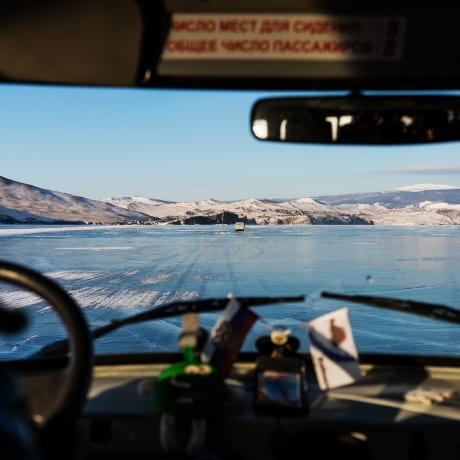

Lake Baikal. In winter, you can drive on it.


Saint-Basil’s Cathedral in Moscow
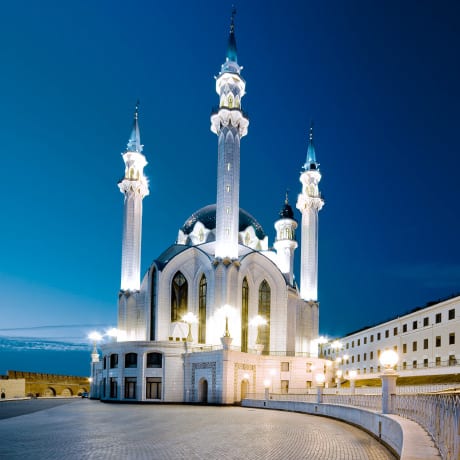

The Kul Sharif Mosque in Kazan


The giant statue of Gengis Khan near Ulaanbaatar
Please note that all the prices and times stated in this chapter were valid at the time of our research in 2020. The timetable of the main trains in Russia is very stable. It hasn’t changed much over the years. However, since then, a world pandemic has occurred and a war involving Russia is still going on. So, be aware that the following prices and times are probably not that accurate.
The routes below are for the Trans-Siberian, Trans-Mongolian and Trans-Manchurian trains and some other international lines.
Eastbound trains always have an even number, and westbound trains always have an odd number.
Be careful, as the international trains on Trans-Mongolian and Trans-Manchurian routes don’t have 3rd class. Nonetheless, it’s the one that RTW travellers usually go for, especially as it’s significantly cheaper. For those looking to reduce travel costs as much as possible, even if it means doing more stopovers and taking a few more trains, see the next section for the cheapest alternative routes.
last update of this table : january 2020
|
Numéro, Nom du Train, & jour de départ |
Dist-
ance (km) |
Décalage
horaire depuis Moscou |
2 Rossiya
(Transsibérien) |
100
(Transsibérien) |
4
(Transmongolien) |
20 Vostok
(Transmanchourien) |
72 – 74 -14 | 6 | 306 | 24 |
|---|---|---|---|---|---|---|---|---|---|---|
| Tous les deux jours | Chaque jour | Chaque mardi | Chaque samedi | Chaque jour |
Mercredi
1 toutes les 2 semaines |
Lundi, mercredi,
vendredi |
1 ou 2 par semaine | |||
| Moscou | 0 | 0 | 23h45 j. 1 | 00h35 j. 1 | 23h55 Mar. | 23h45 Sam. | – | 23h55 Mer. |
|
|
| Nizhni Novgorod | 461 | 0 | 05h50 j. 2 | | | 06h00 Mer. | 05h50 Dim. | – | 06h00 Jeu. |
|
|
| St Pétersbourg | – | 0 | | | | | | | | | 17h09 j. 1 | | |
|
|
| Perm | 1 397 | 2 | 22h06 j. 2 | 05h40 j. 2 | 22h14 Mer. | 22h06 Dim. | 00h45 j. 3 | 22h14 Jeu. |
|
|
| Yekaterinburg (Sverdlovsk) | 1 778 | 2 | 03h34 j. 3 | 12h04 j. 2 | 03h44 Jeu. | 03h34 Lun. | 06h12 j. 3 | 03h44 Ven. |
|
|
| Omsk | 2 676 | 3 | 17h02 j. 3 | 02h32 j. 3 | 16h52 Jeu. | 17h02 Lun. |
|
16h52 Ven. |
|
|
| Novosibirsk | 3 303 | 4 | 01h41 j. 4 | 12h34 j. 3 | 01h23 Ven. | 01h41 Mar. |
|
01h23 Sam. |
|
|
| Krasnoyarsk | 4 065 | 4 | 13h23 j. 4 | 01h14 j. 4 | 13h01 Ven. | 13h23 Mar. |
|
13h01 Sam. |
|
|
| Irkoutsk | 5 152 | 5 | 07h35 j. 5 | 20h44 j. 4 | 07h13 Sam. | 07h35 Mer. |
|
07h13 Dim. |
|
|
| Ulan Ude | 5 608 | 5 | 14h51 j. 5 | 05h29 j. 5 | 15h45 Sam. | 14h51 Mer. |
|
15h45 Dim. | 15h45 j. 1 |
|
| Naushki (frontière russe) | 5 864 | 5 | | | | | 19h57 Sam. | | |
|
19h57 Dim. | 19h57 j. 1 |
|
| Suhe Bator (frontière mongole) | 5 887 | 5 | | | | | 22h29 Sam. | | |
|
22h29 Dim. | 22h29 j. 1 |
|
| Ulan Bator | 6 265 | 5 | | | | | 06h50 Dim. | | |
|
06h50 Lun. | 06h50 j. 2 |
|
| Dzamin Uud (frontière mongole) | 6 770 | 5 | | | | | 18h50 Dim. | | |
|
|
|
18h50 j. 1 |
| Erlian (frontière chinoise) | 6 780 | 5 | | | | | 21h00 Dim. | | |
|
|
|
21h00 j. 1 |
| Zabaikalsk (frontière russe) | 6 626 | 5 | | | | | | | 12h30 Jeu. |
|
|
|
| |
| Manzhouli (frontière chinoise) | 6 638 | 5 | | | | | | | 23h59 Jeu. |
|
|
|
| |
| Harbin (heure locale) | 7 574 | 5 | | | | | | | 12h50 Ven. |
|
|
|
| |
| Pékin | 7 622 | 5 | | | | | 14h35 Lun. | 05h49 Sam. |
|
|
|
14h35 j. 2 |
| Khabarovsk | 8 492 | 7 | 19h32 j. 7 | 16h53 j. 7 |
|
|
|
|
|
|
| Vladivostok | 9 258 | 7 | 06h55 j. 8 | 06h45 j. 8 |
|
|
|
|
|
|
| Prix compartiment 1re classe (SV) | 601 € | / | 888 € | 951 € | 166 € | 498 € | 109 € | 146 € | ||
| Prix compartiment 2e classe (Kupé) | 282 € | 181 € | 551 € | 608 € | 69 € | 318 € | 70 € | 98 € | ||
| Prix compartiment 3e classe (Patskart) | 170 € | 112 € | / | / | 56 € | / | / | / |
Trains that cross the China – Russia, Russia – Mongolia and Mongolia – China borders are more expensive, especially the Trans-Mongolian and Trans-Manchurian trains whose tickets are also sometimes difficult to get. As well as customs procedures, the wagons need to be adjusted to changes in the rails, which takes several hours.
Crossing borders by bus is usually cheaper and quicker. This is a better option for most travellers.
Other cheaper, less busy routes are doable if you go through other border posts between Russia and China, which aren’t on the Trans-Manchurian and Trans-Mongolian routes, but instead on the final part of the Trans-Siberian and the Baikal – Amur or BAM line (cf. route maps).
In English, that’s the 1st class sleeping compartment. In China, you hear of deluxe soft sleepers. Two berth compartments. Very few RTW travellers choose this class and many regretted this decision. You sleep better there, however, it’s not very sociable and above all, it’s almost twice the price of a 2nd class sleeping compartment (kupe).
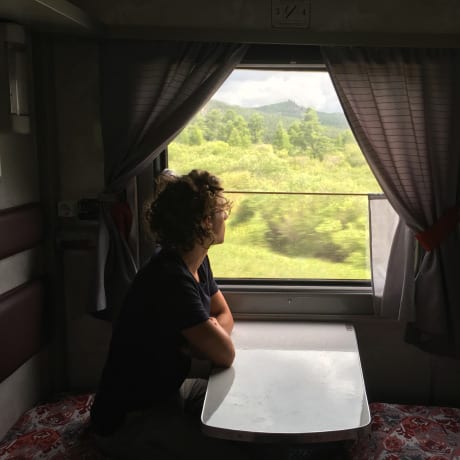

Alone in first class on an express train between Irkutsk and Ulan-Ude
Credit: Christophe Vadot


1st class on the Trans-Mongolian
In English, that’s the 2nd class sleeping compartment. Four berth compartments. In China, you hear of soft sleepers. Sometimes this class is referred to as hard sleepers. When that’s the case, it means that there’s a very slight difference in comfort compared to the soft sleeper class and it may be called 3rd class.
This class can be great when you have good compartment buddies, which is really a matter of luck.
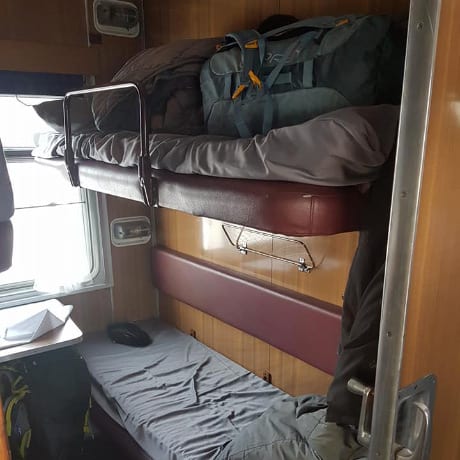

The visible half of a kupe compartment between Krasnoyarsk and Irkoutsk


Kupe class on the Trans-Mongolian, view from the corridor
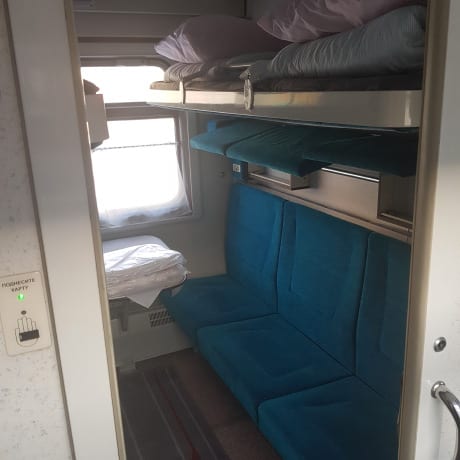

Kupe class between Irkoutsk and Ulaanbaatar
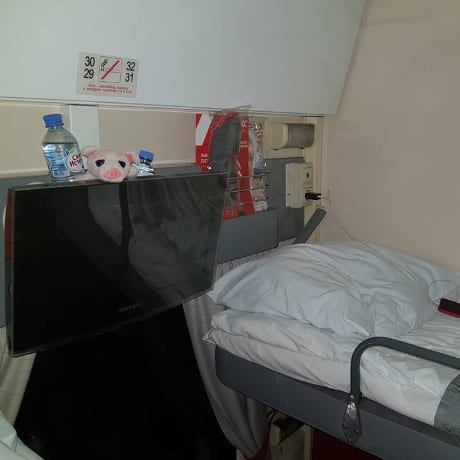

There’s even a TV in this kupe compartment
In English, that’s the 3rd open-class sleeping compartment.
This is the most popular class (by far) amongst RTW travellers. 65% of our survey respondents travelled in this class at least once.
The compartments are open, with just an aisle between the two sides of the train. But each compartment has partitions. There’s not much privacy in this dormitory-style carriage.
In Russia, each “compartment” has four beds. On the other side of the aisle are 2-berth compartments running laterally throughout the length of the train. The 4-berth compartments are a few inches shorter than other classes, around 5’9” (1m80), so taller people will simply have their feet sticking out the end or be slightly bent.
However, on the other side, the 2-berth compartments are partitioned on each side. Subsequently, you can’t stick your feet out, which is unfortunate for people over 5’7” (1m75). The lower berth, on the 2-berth side, folds up to form two seats on either side of a small table.
In China, they call them hard sleepers. The layout of the berths is slightly different. They’re on three levels instead of two. There isn’t a bunk by the aisle, just small seats and tables to sit at during the day.
Most long-term travellers find it perfectly comfortable.
This class has the advantage of being a lot cheaper and more social, but sometimes noisier and brighter. You won’t find this class on all trains, especially not international trains*. We particularly advise women travelling alone to choose this class to avoid ending up in a compartment with bad company on a long journey.
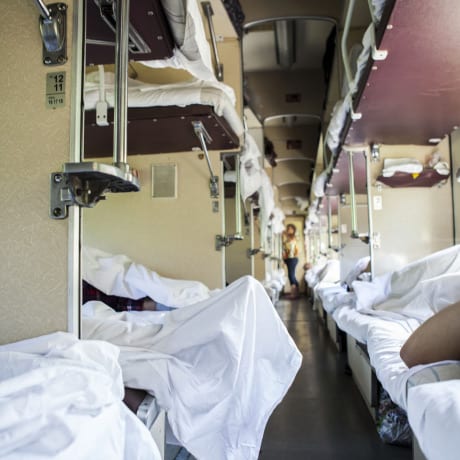

Platskart waking up on the n°100 Trans-Siberian train
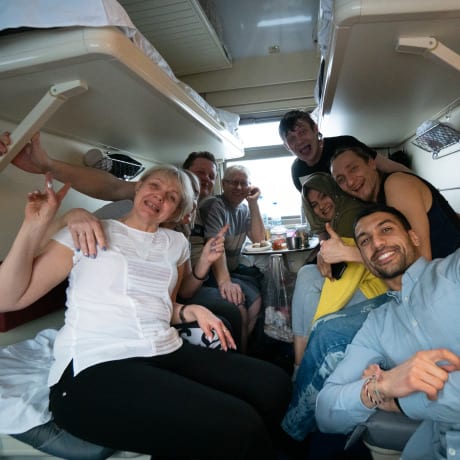

Relaxed atmosphere in platskart class
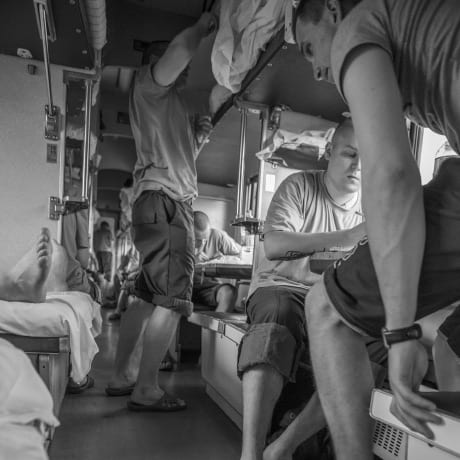

Young soldiers in platskart class


The hard sleeper class on Chinese trains
This is a normal seat. There are also, on many long-distance trains, wagons (without bunks) for those who’re only making short trips.
Everyone has their own preference. You store your luggage in the bottom bunk which opens like a trunk in kupe class. When you choose this one, you can therefore easily access your bag without disturbing anyone and don’t have to climb to get into bed.
On the other hand, during the day, everyone will share it since it also serves as a communal seat. Out of courtesy, you’ll be encouraged to get up earlier so that everyone can sit down.
If you choose the top bunk, you can sleep there as much as you want and lie down there quietly at any time.
In platskart, the top bunk, the ones in the corridor and the ones near the toilets are sometimes cheaper.
Whatever the class, the toilets are communal and are located between each carriage. There’s a toilet cubicle and a space with a sink that you can use to freshen yourself up or get changed. There isn’t a shower, so it’s a good idea to take a washcloth.
These areas are cleaned very regularly. Even in 3rd class, where more people share this “hygiene” space, it’s usually clean and not too busy.
In Russia, you hear about the firmeny class for premium trains.
They’re the fastest, most comfortable and best equipped, but also the most expensive, especially as they don’t always have a 3rd class carriage.
Trains with just a one-digit number (sometimes followed by a letter) are all firmeny. Some firmeny trains even have a name as well as their number. A bit like the high-speed train from Paris – London called the Eurostar, you hear of the Rossiya, the Baikal, the Vostok, etc.
These are slightly less comfortable trains that stop a little more regularly. Therefore, on a Skory train, the same trip is a little longer. On the other hand, they’re a little cheaper. Most RTW travellers who make stopovers use these trains. They usually have a two-digit number and a letter.
These trains have a three-digit number. They stop much more frequently and are therefore slower. They don’t routinely have all the classes (especially the more comfortable ones) nor a dining car.
Trans-Mongolian tickets (No. 3 and No. 4) are often all sold out several weeks in advance, especially in the west-east direction. This is also true, to a lesser extent, for Trans-Manchurian trains (No. 1 and No. 2) and train n°6, Moscow – Ulaanbaatar.
Certain times of the year are very popular. Particularly in the summer and in September when lots of Mongolian students go to China. Private agencies buy tickets in bulk as soon as they’re available for sale, so that they can sell them on for more. The likelihood of getting a ticket at the station, even far enough in advance, is low. For these trains, unless you have a friend out there who can buy your ticket for you at least a few weeks in advance, it’s safer to buy your tickets online via a travel agency website, even if it means paying a commission.
Seats on Trans-Mongolian trains (No. 3 and No. 4) are even harder to get in Ulaanbaatar than from Moscow or Beijing. Sales are only open a few days before departure. The Ulaanbaatar – Beijing ticket (No. 23 and No. 24) is usually easier to get.
No need to panic! There are other solutions if these trains are full! The vast majority of RTW travellers do the same journey without any problem by taking other trains. See our chapter on alternative routes.
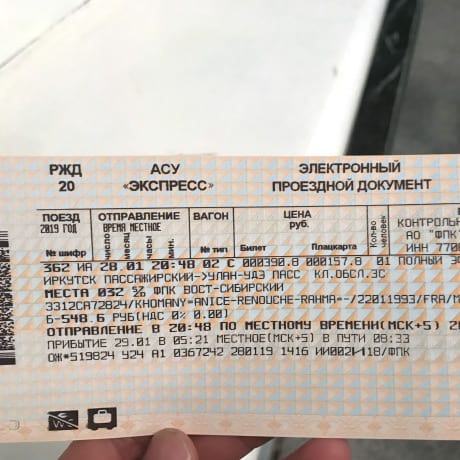

A train ticket from Ikoutsk to Ulan-Ude
As explained above, for international, Trans-Mongolian, etc. tickets, it’s better to buy them several weeks in advance, at least in high season.
Watch out, on Russian trains, tickets go on sale 45 days before departure, not before.
Generally speaking, prices can vary over time and even double. Algorithms that manage transport prices are usually pretty random. At the time of our tests on the Russian website rzd.ru, between March and April 2019, the advertised fare prices of tickets bought at the last minute were often cheaper than the others.
Yes. 46% of our survey respondents bought their tickets directly at the train station. It’s also the cheapest way since nobody takes a commission on the sale.
Trains inside Russia are quite easy to get the day before or the day of departure, especially in 3rd class (platskart) and when travelling alone.
It’s still better to plan a few days in advance or be flexible on the time, the exact date of departure or the class. Ticket office staff very rarely speak English. However, you can overcome this difficulty by learning some essential Russian words to ask for a train ticket.
Don’t think twice about having your destination station, the train number and the class you wish to travel in written on a piece of paper. All of that written in Cyrillic, of course.
You can buy a ticket, even for an international train, from any station. That said, as explained before, whether in Russia, Mongolia or China, tickets are very often all sold out at the station, sometimes a long time in advance. If you don’t want to take any risk at all, it’s better to buy them through an online travel agency.
Tip: in Russia, in the big stations, you can pay a small surcharge of just over one dollar (around 200 roubles) to get your tickets from a “service centre” (servis tsentr). This will help you avoid waiting in long queues.


In Vladivostok train station
Credit: Christophe Vadot
In Ulaanbaatar, you can’t buy tickets directly at the station. The tickets are sold in the building next door, and international tickets are sold on the second floor, where the staff should be able to speak English.
International ticket office: 2nd floor, 8am – 8pm, Monday – Friday
In China, the cheapest way is to buy tickets directly at the station, but not all stations sell international tickets.
There are travel agencies in capital cities and some major cities. They’ll take a commission, but it’s less than those from online international agencies and their staff speak at least a basic level of English. Going through an agency also means that you’ll avoid long queues. Only 1% of our survey respondents went through a local travel agency.
27% of our survey respondents bought their tickets through an online travel agency.
41% of our survey respondents purchased their tickets through the official Russian Railways website.
The official Russian Railways website rzd.ru isn’t the best. Not everything is translated into English and not everything is 100% clear.
Nonetheless, you can still manage to buy tickets for national trains without too much hassle.
Be careful, as you can’t buy international tickets from the website. Although you can view train schedules to Mongolia and China, you can’t complete the purchase online. However, tickets can be purchased at the station.
Again, be careful, as searches on these trains often come up as sold out. However, this doesn’t mean that the tickets aren’t still available through agencies which buy them in advance to resell them for a higher price.
The international routes page provides lots of interesting details about international routes from Russia. The long distance timetable page lets you view train availability over several months on a useful and concise table.
Trip.com is all in English and works great for getting timetables and buying Chinese domestic tickets (only).
ubtz.mn is the official Mongolian website. Unfortunately, it’s entirely in Mongolian and nothing else. On Chrome it can be translated into English by right-clicking translate. First you need to sign up to use it. You’ll eventually manage to see timetables and prices without too much hassle. But the best thing is to go and buy your ticket at the station.
The provodnik or provodnitsa is in charge of the carriage. It’s usually a woman. She welcomes passengers on board.
She takes care of cleaning the bathrooms. She makes sure that the samovar (urn) always has hot water available. She brings you your sheets. She might sell some food and snacks. She even comes to wake you up when it’s time for you to get off.
A sheet, a pillow, a pillowcase and a towel are almost always provided. When this isn’t the case, the provodnitsa will offer them to you for just a few dollars / pounds.


A provodnitsa next to her carriage
Credit: Christophe Vadot
In every carriage, there’s a large samovar at the end of the corridor. It’s a typical object of Eastern countries that’s used to heat water. It’s there so that you can fill up your cup of tea or your pot of instant noodles.
Sometimes there’s drinking water available in front of the samovar. Water from the bathroom sinks is not drinkable. To be sure to have fresh water, you’ll need to have your own water bottle or buy a bottle.
Compared to the usual standard that most RTW travellers are used to, we can confirm that the trains on the Trans-Siberian routes are comfortable.
The level of comfort still varies and mainly depends on the class you choose, but also on the train itself. The newer premium trains are more comfortable and better equipped than the express trains.
We talk about this in detail in the previous chapter on train class and types of train.
In winter, the carriages are heated really well, if not a little too much. In summer, they’re usually air-conditioned, but not always, especially on express trains. Sometimes, on the same train, one carriage from one class has air-con when another carriage from the same class doesn’t. So you’ll be pretty warm. It’s important to take this detail into account when buying your ticket.
Passengers worry less about their style and more about their comfort. Once settled in, everyone gets comfortable, like a lazy Sunday at home. People walk around in sweatpants instead of jeans, especially in the evening. Almost everyone wears flip-flops, sandals or even slippers.
Of course, if you plan on going out on the platform, you’ll need warm clothes at hand.


These Russians stay in their pyjamas for a short train stop
The sockets are the same C / F type found in most European countries.


Here is the C type, so you’ll problably need an adapter
No matter what train it is, you’ll always find a socket in each 1st class compartment and another 110V one in all bathrooms, regardless of the class.
In 2nd and 3rd class, everything depends on the train. More often than not, there’s only one socket in the corridor and opposite the bathrooms where you can charge your devices and keep an eye on them.
Newer trains, or those in the premium or “firmeny” class, are better equipped in this department and often have one, if not two, sockets per 2nd and 3rd class compartment.
If there’s an emergency and you need access to electricity, it’s acceptable to ask the provodnitsa if they can charge your phone for you in their compartment. Out of politeness, you should give them a tip, around $5, for their help.
Here are the suggestions that came up most often amongst the 75 RTW travellers who answered this question:
On board, you can buy tea and coffee from the provodnitsa. A drinks and snacks seller sometimes passes through the carriages.
Passengers always make sure they have their own food. With hot water being free, many opt for instant noodles, but you’ll also see dried fish, salads, sandwiches and cured sausages… You can get supplies from all the sellers who wait on the platforms. They sell snacks and even some dishes for a reasonable price.
During the longer stops in big cities (rarely more than 20 minutes), you’ll just about have time to go to a kiosk in the station. It’s a good idea to ask the provodnitsa for the green light and do it “pronto”.
Having a pic-nic on the communal table is the best time to socialise and share. It’s not uncommon for others to offer you a bit of this or that, a glug of beer or a shot of vodka. Don’t hesitate to do the same in return.
Otherwise, there’s also the dining car option. But there isn’t always one, particularly on lower class trains and shorter journeys. Sometimes, it’s just a buffet car. On Trans-Siberian, Trans-Mongolian and Trans-Manchurian trains, the restaurant on-board is open from 10am to 10pm and they serve basic food that changes depending on the country you’re in. The menu costs around $10 to $30 (£10 to £20), but you can only pay in the local currency. The dining car is changed at border crossings. In Russia, on the menu you’ll find potatoes, soups and escalopes, ravioli or small stuffed pasties, whilst the restaurant on Mongolian railways serves rice and mutton. The Chinese company offers a unique menu, often consisting of several small dishes. In Russia, waiters and waitresses are usually tipped, around 5 to 10% of the bill.
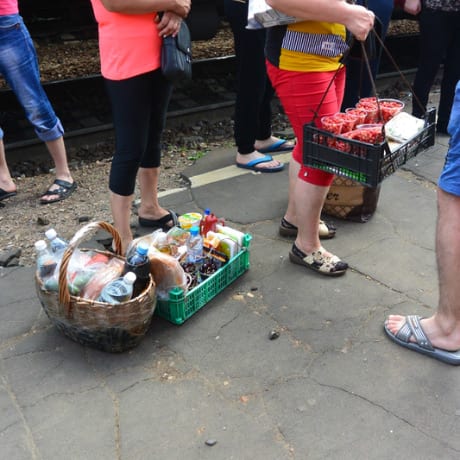

Seller on the platform
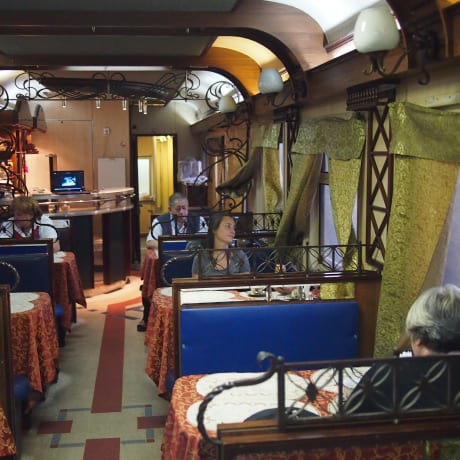

Dining car on a Trans-Mongolian train
Very few people speak English in Russia. There aren’t as many foreign tourists on the trains, especially outside the summer months. Off-season, there’s a good chance you’ll be the only one in your carriage and will therefore attract quite a crowd. People will be curious and try to talk to you.
Like anywhere, it’s always a good idea to be able to speak the local language, at least a little. Trans-Siberian trains are the ideal place to learn and practice.
We advise you to take a Russian language instruction book, or at least a dictionary or phrasebook. And, of course, the least you can do is learn to decipher the Cyrillique alphabet.
Nowadays, electronic translations on our phones are pretty high-performance and extremely handy. You can download Google Translate and use it offline. It’s easy and it’s free – take a look at this tutorial.
If you want to socialise and overcome the language barrier, we strongly recommend bringing food and beverage specialities from your country to share with others, having a few photos to show, taking a musical instrument that’s not too bulky and some simple games.
Alcohol is banned everywhere, except for the dining car, where it’s sold and can be consumed there.
In reality, nobody sticks to this rule.
We even advise you to bring something to drink with your compartment buddies who’ll most likely get a bottle out at some point as well. Of course, abusing it and behaving “inappropriately” runs the risk of getting a fine and being kicked off the train.


Vodka aperitif on the train
Reading is a great pastime on a train, but not really a way to open up to others.
For that, there’s a tried and tested method: playing games! The most popular Russian card game is Durak, and we suggest learning it here.
Feel free to brush up on the rules of your favourite card games. You won’t regret taking a basic little game with you like Doodle or mini chess and checkers.
Everyone in all classes has a 35 kg luggage allowance and up to 50 kg in 1st class Russia. On domestic routes in China, the limit is 20 kg. But you’d look like a hawker if you carried that much weight in your backpack.
Buggies and other baby equipment aren’t seen as luggage and therefore aren’t taken into account.
The bottom bunker lifts up like a trunk and you can store your luggage in it. You need to get a small day bag ready with all the essentials for the trip.
Whatever the class (with some rare exceptions) the sanitary facilities are shared by the whole carriage.
The ends of the carriages are equipped with sanitary facilities (toilets and sinks). The toilets are western style. The area is regularly cleaned and everything’s in order. The provodnitsa ensures that there’s always toilet paper available.
There isn’t a shower. The best way to maintain an acceptable level of hygiene is to go to the facilities in flip-flops and wash yourself with a washcloth or wipes. You’ll find hooks to hang your clothes on.
There aren’t any specific safety issues on the trains. To avoid theft, it’s best to take some basic, common sense precautions. Keep your ID, money and valuables in a bag near you.
You’re never protected from unfriendly or sometimes drunk bunk neighbours. In this case, being in a closed 1st or 2nd class compartment isn’t very safe. The provodnitsa is always there to help you sort out these kinds of problems, if they get too serious. The best way to avoid them is to go for 3rd open-class which looks like a big dormitory. Being visible to everyone is more reassuring.
Smoking is forbidden on the train, although a few people are occasionally seen smoking very quickly in the connecting areas between carriages. You can smoke on the platform when the train makes a stop.
It’s quite surprising, yet from time to time you get 3G on the train, sometimes in the middle of nowhere and more often around cities.
According to the Russian Railways website, the transport rules state that bulky luggage must go in the luggage car.
It can transport bikes and motorbikes up to 364 lbs (165 kg). The latter must be packaged, but this isn’t compulsory for push-bikes.
To do this, you need to buy a special luggage ticket on top of your passenger ticket. Depending on the station, you have to go to the special luggage office, directly to the ticket office or simply buy it online on the RZD website. It’s the same procedure on trains in China.
Motorbikes over 364 lbs (165 kg) have to be transported separately by cargo trains. The vehicle is picked up at the warehouse.
A traveller called Stephan explained on a travel forum how he organised this quickly and simply by going through JDE express. Given that their website is solely in Russian, he went directly to their warehouse which is located very close to the Irkutsk station.
As an example, sending a bike this way from Irkutsk to Moscow only costs $30 (£20).
You can buy and use a bunk for your bike.
If it’s well packaged and secured to the bunk, there’s no reason for this to be a problem.
The technique, which is most popular amongst cyclists, involves buying a luggage ticket and going to meet the car manager to ask them for permission to put your bike in the connecting area between carriages. Negotiating this is usually pretty easy.
Always remove the wheels from the bike, then wrap everything in plastic and really tape it up or (much better) use a transport bag made for big bicycles such as this one.
For international trips, Irkutsk – Ulaanbaatar – Beijing, it seems to be more complicated. It’s likely you’ll have to send your bike by cargo.


Anabelle and Loris’ bikes in the connecting area between carriages
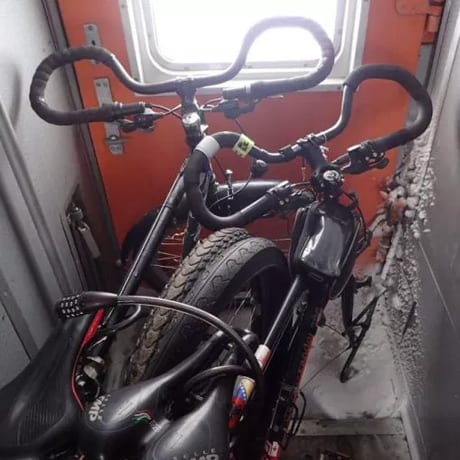

It was difficult to fit the unpackaged bikes in from Irkutsk – Vladivostok
Credit: Elsa & Anaïs
Travelling thousands of kilometres by train is extraordinary. Finishing it or starting it on a plane, isn’t that a bit of a waste?
Did you know that you can go from London to Beijing exclusively by train?!
You can quickly get from London to Paris by train.
Then there are two direct sleeper trains between Moscow and France which go through Paris and Strasbourg or Nice. There are many more from major European cities. Perhaps this is a good opportunity to include a European tour in your RTW trip or your Trans-Siberian travel plans?
There isn’t a sleeper train that goes directly from London to Moscow. For that, you’ll have to go to France first. So, leaving London, the first step is to take the direct train between London and Paris. This is called the Eurostar. The journey only takes 2.5 hrs by passing through the Channel Tunnel. Unfortunately, tickets are often very expensive. The price of a one-way ticket can vary between $55 and $270 (£40 and £200). To get the best price, you need to buy your ticket at least one month in advance. To view the full fare table, go to the Eurostar website.
To get to Paris from London, you can also take a bus. There are several buses every day. It takes a lot longer (about 8.5 hrs), but it’s also a lot cheaper. BlaBlaBus’ average price is around $35 (£25).
For all train journeys that pass through Belarus, a transit visa which costs $70 (£50) “seems” to be mandatory. See the visas chapter for more details. Customs controls are carried out directly on board when crossing the Belarussian border.
One train per week. Thursdays from Paris. Tuesdays from Moscow. The trip takes 40 hours. It passes through Strasbourg, Berlin, Warsaw (Poland) and Minsk (Belarus). Oddly, the compartments aren’t mixed according to the Oui SNCF website, but not the rzd.ru Russian website states the opposite. More information on this train and its route are detailed on the Russian Railways page rzd.ru.
Total between $355 and $395 (£265 and £290)
One train per week. Thursdays from Moscow and Sundays from Nice which is in south of France in the french riviera. The trip takes 48 hrs. It goes through Italy, Austria, Slovenia, Poland and Belarus.
The cheapest option is in a 2nd class berth: fare around $340 (£250)
First off, you need to go to Berlin. There are buses and trains every day. The cheapest Thalys train from Paris leaves at 8.15 am and costs $200 (£150). Or, there’s a Eurolines night bus that leaves every day from Paris. The fare is less than $35 (£25) on Oui SNCF and it’s a 14.25 hrs trip.
Once in Berlin, there are two direct night trains per week, Saturdays and Mondays, from the Berlin Ostbahnhof station. The journey takes about 25 hrs and passes through Poland and Belarus.
It seems like you can’t buy the ticket online from the official Deutsche Bahn website, but you’ll probably be able to buy the ticket directly at the ticket office in Berlin. It’s a Russian train from the national company RZD. You can buy the ticket on their website (russian).
It costs around $170 (£125) for a standard berth and barely $17 (£12.50) less for a normal seat.
Total between $365 (£265) and $205 (£150)
There isn’t a land checkpoint between Belarus and Russia. For this reason, according to the Russian rules, it’s therefore theoretically prohibited for a foreigner to enter Russia by train (or even by car).
However, the majority of trains heading to Moscow from major European cities go through Belarus, which is extremely contradictory.
With regard to this matter, the British Foreign, Commonwealth and Development Office (FCDO) states on its website:
“If you’re planning on travelling by rail between the two countries, you should contact your train or tour operator when you make your booking to seek their advice. You should also consider contacting your nearest Russian embassy or consulate for advice on the latest situation for rail travellers.”
Two RTW travellers told us firsthand that they did this trip by train from Nice – Moscow and Paris – Moscow, without any problems at all. Other 2018 testimonies on the seat61 website further confirm this information.
These travellers didn’t encounter any customs controls at the Russian border. They subsequently got their passports stamped at the time of their first registration, once they’d arrived in Russia.
If you still want to avoid going through Belarus, you’ll have to go through Latvia, Estonia or Ukraine. This’ll ultimately take at least another 24 hours and be more expensive, even considering the savings on the Belarussian visa.
Last update of this table : january 2020
| Service | Destination | Frequency | Departure from Russia | Departure to Russia | Approximate time | Stops in train stations | Price (cheapest) | Class (cheapest) | Where to buy tickets |
|---|---|---|---|---|---|---|---|---|---|
| No. 9 / 10 Moscow – Warsaw | Poland | 3 per week | Mondays, Wednesdays, Fridays | Tuesdays, Thursdays, Saturdays | 19 hrs | Smolensk, Minsk, Brest | $124 (£91) | 2nd class compartment, economy bunk | rzd – Polish Railways (PKP) |
| No. 21 / 22 Moscow – Prague “Vltava” | Czech Republic | 1 per week | Mondays | Wednesdays | 28 hrs | Smolensk, Minsk, Brest, Warsaw, Bohumin | £259 (£192) | 2nd class compartment, economy bunk | rzd |
| No. 17 / 18 Moscow – Nice | France (via Italy) | 1 per week | Thursdays | Sundays | 48 hrs | Smolensk, Minsk, Brest, Warsaw, Bohumin, Vienna, Innsbruck, Verona, Milan, Genoa | $379 (£280) |
|
rzd, Ouisncf |
| No. 13 / 14 Moscow – Berlin “Strizh” | Germany | 2 per week | Fridays, Sundays | Saturdays, Tuesdays | 22 hrs | Smolensk, Minsk, Brest, Warsaw, Poznan, Frankfurt | $224 (£166) | 2nd class compartment, economy bunk | rzd |
| No. 23 / 24 Moscow – Berlin – Paris | Germany, France | 1 per week | Thuesdays | Thursdays | 40 hrs | Smolensk, Minsk Brest, Warsaw, Poznan, Frankfurt, Berlin, Karlsruhe, Strasbourg | $384 (£284) | 2nd class compartment, economy bunk | rzd, Ouisncf |
| No. 32 / 31 Moscow – Helsinki “Lev Tolstoy” | Finland | 6 per week | Except for Saturdays | Except for Saturdays | 14 hrs 40 min | Vainikkala | $117 (£86) | 2nd class compartment, economy bunk | rzd |
| No. 781 – 788 St. Petersburg – Helsinki “Allegro” | Finland | Every day | Every day | Every day | 3 hrs 36 min | Vyborg, Vainikkala, Kouvola, Lahti, Tikkurila, Pasila | $67 (£49) | Economy seat | rzd |
| No. 1 / 2 Moscow – Riga | Latvia | Every day | Every day | Every day | 16 hrs | Of no interest | $91 (£67) | 3rd class compartment, economy bunk | Latvian railway, rzd |
| No.29 / 30 Moscow – Vilnius | Lituania | Every day | Every day | Every day | 14 hrs | Minsk | $77 (£57) | 3rd class compartment, economy bunk | Lithuanian Railways, rzd |
| No.33 / 34 Moscow – Tallinn | Estonia | Every day | Every day | Every day | 16 hrs 30min | St Petersburg | $88 (£65) | 3rd class, open sleeping | rzd |
Travellers who decide to get to Moscow overland will surely consider taking some time to visit Europe, rather than going there as quickly and directly as possible. For them, an Interrail pass might be an attractive option.
Watch out, as Interrail doesn’t operate in Russia. You’ll have to do the last part of this journey in a different way.
This train pass is for Europeans only, including Brits (even since Brexit). It can be purchased on the Interrail.eu website. It allows unlimited boarding on most trains in most European countries (including Turkey), without needing to buy tickets.
European countries where Interrail doesn’t operate:
Russia, Ukraine, Albania, Estonia, Latvia, Moldova and Belarus.
Interrail’s real drawback is that it doesn’t make bookings on many trains, especially high-speed trains and night trains. For each booking, you’ll need to allow for $10 to $20 (£10 to £15) on top of the price of the pass, which, combined, isn’t cheap.
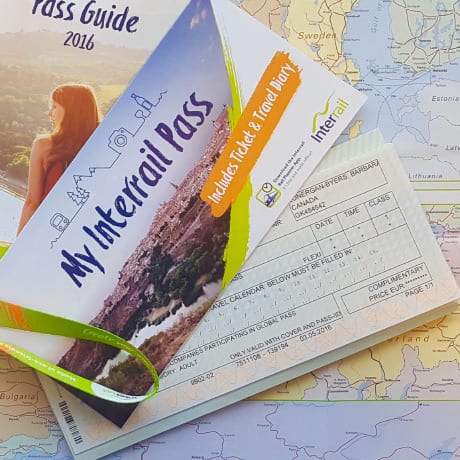

Interrail pass
| Interrail Global Pass | Youth
(12-27) |
Adult
(28+) |
Child
(4-11) |
Senior
(60+) |
|---|---|---|---|---|
| 4 days within 1 month | £165 | £219 | £0 | £197 |
| 5 days within 1 month | £189 | £251 | £0 | £226 |
| 7 days within 1 month | £223 | £298 | £0 | £269 |
| 10 days within 2 months | £268 | £357 | £0 | £321 |
| 15 days within 2 months | £329 | £439 | £0 | £395 |
| 15 days continuous | £295 | £394 | £0 | £355 |
| 22 days continuous | £346 | £461 | £0 | £415 |
| 1 month continuous | £448 | £596 | £0 | £537 |
| 2 months continuous | £488 | £651 | £0 | £586 |
| 3 months continuous | £603 | £803 | £0 | £723 |
Prices on interrail.eu in October 2022
There is indeed a train, three times a week, which allows you to go from Vladivostok to Pyongyang in North Korea. You’ll have to change at Ussuriysk.
There’s also a train from Beijing to Pyongyang.
North Korea is a very closed off country which doesn’t make it easy for tourists to enter its territory and getting there by train adds another difficulty. The seat61 website has gathered stories from travellers who’ve done these journeys.
| Type of visa | Maximum duration of stay | Validity period | Standard processing time | Express processing time | Standard price | Express price | Possible extension |
|---|---|---|---|---|---|---|---|
| Tourist visa, single, double or multiple-entry | 30 days (single and double), 180 days (multiple) | 3 months (single), 36 months (multiple) | 4 – 20 business days | 3 business days | $160 | $160 | – |
| Transit visa | 10 days | 10 days | 4 – 20 business days | 3 business days | $160 | $160 | – |
U.S. citizens need a visa to travel to Russia. They’re advised to apply for a multiple-entry tourist visa regardless of their entry / exit date, number of entries or duration of stay. This visa is valid for three years and can be used for a stay of six months or less. Whereas, the single-entry tourist visa is only valid for three months and can’t exceed a stay of 30 days.
To apply, you need to complete the online visa application form. Then, you need to print it out and go to one of the Visa Application Centres to apply. The standard service takes 4 to 20 business days and the express service takes 3 business days, and all visas cost $160. You can also apply by post but the process is longer and more expensive.
There’s also a transit visa that travellers should use if they’re transiting through Russia for over 24 hours. They’re issued for up to 10 days when travelling by train. The application process is the same, and you’ll need to provide proof of the visa of your destination country as well as onward tickets. If you’re travelling to Belarus via Russia, you must obtain a transit visa.
Addr: 2650 Wisconsin Ave., NW Washington, DC 200007
Tel: (202) 939-8914
Email: [email protected]
| Type of visa | Maximum duration of stay | Validity period | Standard processing time | Express processing time | Standard price | Express price | Possible extension |
|---|---|---|---|---|---|---|---|
| Tourist visa, single or double entry | 90 days | Subject to dates of your legal invitation | Up to 20 business days | Up to 3 business days | £63 (single) £101 (double) | £125 (single) £200 (double) | – |
| Transit visa, single or double entry | 10 days | Subject to dates of your legal invitation | Up to 20 business days | Up to 3 business days | £63 (single) £101 (double) | £125 (single) £200 (double) | – |
British citizens need to get a tourist or transit visa before travelling to Russia. The single and double-entry tourist visas can be valid for up to 90 days, and the transit visa is usually valid for 10 days if travelling by train. These short term visa applications are accepted at the Russia Visa Application Centres.
First, you need to complete the Online Application Form. Then, you need to print it out and go to one of the Russia Visa Application Centres in London, Edinburgh or Manchester to apply for the visa. Then, if you’re aged 12 or over, you’ll also need to submit biometric data.
What’s more, you need to have a Tourist voucher/confirmation document stamped and signed by authorized person. As of August 2021, British tourists can now use their booking with a registered Russian hotel, or confirmation from a registered Russian tourist agency to apply for a single, double or multi-entry tourist visa for up to six months. Alternatively many online services can send you a valid voucher for a few pounds (or dollars). look up the terms russia voucher on a search engine. the Single entry visas are valid for the duration of the hotel booking and multi-entry visas allow the tourists to stay in Russia for up to 90 consecutive days out of a 180-day period.
Addr: 5 Kensington Palace Gardens, London W8 4QS
Tel: +44 (0) 203 668 7474
Email: [email protected]
| Type of visa | Maximum duration of stay | Validity period | Standard processing time | Express processing time | Standard price | Express price | Possible extension |
|---|---|---|---|---|---|---|---|
| L / G single entry visa | Subject to Chinese visa-issuing authorities | Subject to Chinese visa-issuing authorities | 4 working days | 2 – 3 working days | $140 | $165 | Yes |
| L / G double entry visa | Subject to Chinese visa-issuing authorities | Subject to Chinese visa-issuing authorities | 4 working days | 2 – 3 working days | $140 | $165 | Yes |
U.S. citizens need to obtain a visa prior to arrival in China. There is an L visa for tourists and a G visa for transit. The traveller’s passport must have at least six months’ validity remaining, unless they’re applying for the ten-year multiple-entry L visa. In that case, the traveller’s passport must be valid for more than one year.
To start the application, fill out the online form on the China Online Visa Application (COVA) website. Make sure the application is submitted to the visa office in your jurisdiction. Take a look at this list to find your jurisdiction. Once completed, dated and signed, it needs to be submitted, in person, and paid for. The standard service processes the visa application within four working days, and the express service processes it within two to three working days.
Ultimately, it’s the consular officers who decide whether to issue a visa, as well as the type, validity period, duration of stay and number of entries, based on each individual application.
Addr: 3505 International Place, NW Washington, DC 200008 USA
Tel: +001-202-495-2266
Email: [email protected]
| Type of visa | Maximum duration of stay | Validity period | Standard processing time | Express processing time | Standard price | Express price | Possible extension |
|---|---|---|---|---|---|---|---|
| L / G single entry visa | Subject to Chinese visa-issuing authorities | Subject to Chinese visa-issuing authorities | 4 working days | 3 working days | £151 | £182 | Yes |
| L / G double entry visa | Subject to Chinese visa-issuing authorities | Subject to Chinese visa-issuing authorities | 4 working days | 3 working days | £151 | £182 | Yes |
British citizens usually need a visa to enter mainland China, and it’s best to organise it one month before you intend on travelling in China. There is an L visa for tourists and a G visa for transit. First, the traveller must complete, print and sign an online application form. Then they must book an appointment at a Chinese Visa Application Centre (London, Manchester and Edinburgh).
On the day of the appointment, in person, the traveller must take their application form, appointment sheet and other important documents to the Visa Application Centre. During the appointment, biometric data might also need to be submitted. The regular service processing time is four working days, and the express service processing time is usually three working days (express application submission is between 9am and 12pm). You must pay on the day, and the Visa Application Centres accept payments in cash or by debit card in pound sterling.
Addr: 49 – 51 Portland Pl, London W1B 1JL, UK
Tel: +44 20 7299 4049
Email: [email protected]
U.S. citizens don’t require a visa to travel to Mongolia, and can stay there visa-free for up to 90 days, as long as the traveller’s passport is valid for at least six months after the date of arrival. If they stay for more than 30 days, they need to register with Mongolian Immigration within the first seven days in the country.
Addr: 2833 M Street, NW Washington DC 20007
Tel: 1 (202) 333 7117
Email: [email protected], [email protected]
| Type of visa | Maximum duration of stay | Validity period | Standard processing time | Express processing time | Standard price | Express price | Possible extension |
|---|---|---|---|---|---|---|---|
| Online tourist visa (K2) | 30 days | 90 days | 5 days / on arrival | 1 day | £40 (single entry), £50 (double entry) | £60 (single entry) | Yes |
| Online transit visa (K6) | 10 days | – | 5 days / on arrival | 1 day | Not specified | Not specified | – |
British citizens should get a visa before they travel to Mongolia. The tourist visa usually allows you to stay in Mongolia for up to 30 days and can be extended for another 30 days, but make sure you do this at least four days before the first visa expires. It’s also possible to obtain a visa on arrival at the Ulaanbaatar airport or Mongolian border checkpoints, however, this isn’t advised as it can cause longer processing times.
What’s more, Brits can now apply for an online visa that is generally issued within 72 hours of application. The online tourist visa (K2) is valid for 30 days, and the online transit visa (K6) is valid for 10 days. Travellers should carry digital or printed versions of their e-visas to present if necessary. Again, these can be obtained at Mongolian borders if the traveller has an onward ticket or a visa for their next country, but this could lead to longer processing times.
Addr: 7 – 8 Kensington Court, London W8 5DL
Tel: +44 (0)20 7937 0150
Email: [email protected], [email protected]
| Type of visa | Number of entries | Maximum duration of stay | Validity period | Standard processing time | Express processing time | Standard price | Express price | Under 14 years |
|---|---|---|---|---|---|---|---|---|
| Transit | Simple or double | 2 days | One year | 5 days | 2 day | $70 (£50) | $135 (£100) | Free |
British and U.S. citizens can enter Belarus for a maximum of 30 days without a visa. However, if you’re travelling directly from or to Russia, this visa-free arrangement doesn’t apply to you and you’ll need a certain type of visa.
From Western Europe, most trains heading for Russia go through Belarus. For travelling through the country like this, the Belarussian embassy recommends getting a transit visa that’s valid the moment you cross the border.
Be careful, as crossing the Belarussian – Russian border is controversial. All the details on this subject can be found above in this paragraph.
More information:
Embassy of Belarus to the United Kingdom
Embassy of the Republic of Belarus in the United States of America
In person:
Embassy of Belarus in the United States of America
Addr: 1619 New Hampshire Avenue, NW Washington DC 20009
Tel: + 1 202 986 1606
Email: [email protected]
Embassy of Belarus in the United Kingdom
Addr: 6 Kensington Court, London W8 5DL
Tel: +44 0 207 937 3288
Email: [email protected], [email protected]
By post:
Send the file in a pre-paid envelope addressed to the Embassy of Belarus. Add an A4 envelope to the file and fill out the recipient details with your first and last name and address, and fill out the sender field with the address of the embassy.
Gareth Leonard’s Trans-Siberian Railway Survival Guide
Follow Gareth on his Trans-Siberian journey in platskart (3rd class). In his videos he gives step-by-step tips to help you deal with all types of situations on board and learn about all the weird and wonderful things you’ll encounter on route. Watching these videos is a real eye-opener to life on board the Trans-Siberian. Check out his other videos for tips and advice on travelling in Russia.
Kara and Nate’s Trans-Siberian Railway Daily Vlogs
Join Kara and Nate, a travelling couple from the USA, on their Trans-Siberian journey from spalny vagon (1st class) to platskart (3rd class). Their vlog offers an in-depth look at life on-board the train, including minute and handy details, such as where to get hot water from, what to eat on board, how to make the most of stops in train stations, and so on.
Naick and Kim’s Trans-Siberian Railway
Hop on board with Naick and Kim as they travel overland from Brussels to Beijing. Their vlog shows you exactly what life is like on Trans-Siberian trains, especially with regards to food. Get ready for lots of footage of instant pot noodles, mashed potato and snacks, as well as their experience in the dining car. Their journey demonstrates how easy it is to meet and talk to people in kupe (2nd class) and platskart, and highlights the friendly atmosphere on board which, again, often revolves around sharing food!
The Traveling Clatt’s Trans-Siberian Railway
Jump into Tal’s Trans-Siberian adventure that starts in London. Via buses and local trains, he navigates his way from England to Russia without a flight. He gives an insight into daily life on board the Trans-Siberian route, from setting yourself up to figuring out how to pass the time (cards are a must!) and how to get data. Tal gives a tour of the classes and gives lots of pertinent tips and information, such as where to get the cheapest tickets, the lack of English and English-speakers and how to be comfortable on board in the rather tight and hot carriages.

